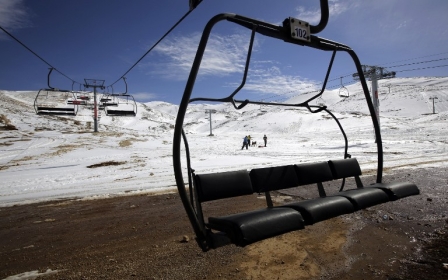Qat habit drains Yemen's precious groundwater

By Hammoud Mounassar
SANAA - Mountainous Yemen is blessed with more water than its Arabian desert neighbours but the national passion for the stimulant plant qat threatens to exhaust that precious resource.
In the mountains around Sanaa, farmers are drilling so many unlicensed boreholes to irrigate the thirsty crop -- craved by the capital's residents --that the water table is falling by as much as six metres (20 feet) a year.
Engineers now have to drill 1,500 metres (nearly 5,000 feet) in some areas before reaching the aquifer.
Qat is an evergreen shrub native to the Arabian Peninsula and the Horn of Africa, and chewing its leaves and shoots as a stimulant dates back centuries.
New MEE newsletter: Jerusalem Dispatch
Sign up to get the latest insights and analysis on Israel-Palestine, alongside Turkey Unpacked and other MEE newsletters
But it is only in the past half century that its consumption has spread from the elite to become a focal point of Yemeni social and business life.
For Yemeni men, an afternoon chewing qat while decked out in traditional robes is an opportunity to cement social ties, seal business deals, or debate the issues of the day. But increasing numbers of women and teenagers also indulge in the habit.
Sales of qat in Yemen are estimated to run to $800 million (5.8 million euros) a year, a huge sum in a country ranked by the United Nations as 160th in the world for human development, the lowest in Asia bar war-torn Afghanistan.
Only 10,000 hectares (25,000 acres) were given over to cultivation of the crop in the 1970s.
But by 2012 that figure had risen to 167,602 hectares (414,153 acres), accounting for 12 percent of Yemen's arable land.
Its attraction to farmers is not difficult to understand. According to the agriculture ministry, qat can earn $12,500 a hectare ($5,000 an acre), three times the revenue of any other crop.
It takes five years to get a harvest from a fruit tree but just a few months for a qat plant, and it can be harvested as many as four times a year.
Lucrative but thirsty
But each crop comes at a heavy cost in water usage as the plants are watered heavily for a month before harvesting to ensure that the tender leaves and shoots that users chew are as soft and moist as possible.
One day's supply of qat for a single user requires an estimated 500 litres (130 gallons) of water to produce.
In Sanaa province alone, there are 4,000 wells drilled without authorisation to irrigate qat, water expert Omar Madhaji said.
Excessive pumping is lowering the level of the water table by three to six metres (10 to 20 feet) a year, he warned.
Geologist Ismael al-Janad said that the Sanaa basin aquifer was being drained at an unsustainable rate.
"The only alternative to the depletion of the water table is to take urgent measures to prohibit the use of water pumped from the aquifer for irrigation," he said.
Water Minister Abdo Razaz Saleh acknowledged that the government had failed to stop unlicensed companies from digging deep wells.
He said 150 such companies operate in Sanaa alone, among 950 nationwide.
The upshot is that in a country that enjoys much higher rainfall that its mainly desert neighbour Saudi Arabia, mains water is heavily rationed, even for those who have it.
In Sanaa, a city of some three million people, only 45 percent of households have mains water and the taps are switched on just twice a week, water authority chief Ali al-Sarimi said.
Everyone else relies on privately owned boreholes.
"Most people in this area depend on the well," said Bashir Nashwan as he queued at one Sanaa pumping station.
"The water is provided by a generous donor. But it is always crowded and we have to queue for hours."
Sarifi said just a third of the three billion cubic metres (106 billion cubic feet) of water that Yemen consumes each year comes from renewable sources.
The rest comes from aquifers that have taken millions of years to form and cannot be replaced.
Middle East Eye delivers independent and unrivalled coverage and analysis of the Middle East, North Africa and beyond. To learn more about republishing this content and the associated fees, please fill out this form. More about MEE can be found here.




